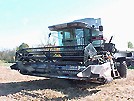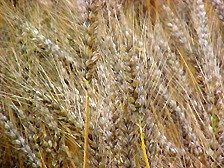 |
PLANTING & HARVESTING TODAY |
 |
PLANTING & HARVESTING TODAY |
|
||||||||
|
These web pages feature information about planting and harvesting grain in Southeastern Pennsylvania. The photos and information were obtained by working with two local farmers in the Pennridge School District.
|
GROWING SEASON FOR GRAIN IN SE PA Corn takes 75- 130 days to mature. It depends on the degree days (how hot it is each day). Primary crops in this region include corn, soybeans,wheat, and oats. Wheat (seen at right) is planted in September and harvested the following July. Corn and soybeans take from 75 to 140 days from planting until harvest. |
 |
CHOICE OF FIELD CROPS
As a farmer considers new types of seed he usually checks how a product has done in a test plot in the region. A farmer often uses seed that he has been successful with, but is always looking for new ways to increase the productivity of a field.
New types of seed are developed as hybrids. Hybrids are different types of corn which are crossed by plant breeders. The mixed origin plant is usually bread to meet certain desired qualities such as being resistant to a certain type of disease, changing the length of the growing season, being drought resistant, and achieving a desired sweetness or other characteristic of the product.
CHALLENGES
|
As a farmer it is always a challenge to deal with mother nature. There are wet conditions, storms, and the wind can blow the crop down, making it difficult to harvest crops. Plant diseases can also cause problems for the crop yield. Crops die such as in the 1999 drought when area farmers lost almost everything that they planted. Federal and state governments helped to pay for the losses. Every farmer that got aid in 1999 must now carry crop insurance to cover the cost of losing future crops when there has been a bad season. |
Farming can be challenging at times according to Ken Beer. It needs to be dryer when it is too wet. For example, for two weeks we thought nothing would grow because it was so dry. We had to decide whether to plant the soybeans 1" deep (normal depth but now too dry to germinate), 1 1/2" deep or 2" deep (where the soil will be wet enough to germinate the seed but not too wet to rot the seed). He then spoke of the heavy rain that came last week, and the potential for the seed to rot where it was planted at the lower depth.
When a farmer makes the wrong decision, this is when fields are spotty with gaps in the rows - where plants do not survive. As a farmer you do not know what will happen the next day - you need a lot of faith to be a farmer according to Ken Beer. You can use irrigation ("make rain") to control the water in a field but the next day, hail can knock the crop to the ground. High humidity and precipitation also effect the success of the crops.